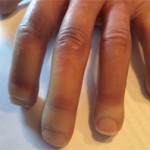When I returned, Dr. Medsger was performing a skin score, a grading system by which the skin of scleroderma patients can be objectively assessed and assigned a total score each visit rather than simply estimating whether the skin is better, worse or the same. He asked me to palpate Dr. Indura’s distal forearm as she repetitively flexed the fingers of her right hand.
Beneath my fingers, I felt a leathery creakiness to the tissues, a tendon friction rub.
“Physical diagnosis still matters; even before the more obvious skin thickening occurs, a tendon friction rub at the wrist or elbow is a distinctive feature of diffuse scleroderma,” Dr. Medsger said.
The lab drew six tubes of blood. In a low voice, Dr. Medsger pointed to a red top tube and asked the tech to run the chemistries STAT. Then he toggled back and forth between listening to the lungs and heart. He repeated the blood pressure and took out his pen and drew a graph with a single curved line on the yellow pad. It rose steeply, leveled out and gradually declined.
“This,” Dr. Medsger declared to the Induras, “is what we believe is the natural history of diffuse scleroderma. Over approximately seven years, even without treatment, most patients’ skin scores level off, and eventually, there is some degree of softening. The trunk, followed by the face and proximal limbs improve first, while the earliest skin changes in the hands are last, and they may not resolve completely. Now, of course our ultimate goal is to cure scleroderma, but if we can’t cure the disease today, our goal is to compress the curve, limit skin tightening and aggressively treat internal damage when it first arises.”
He looked up. The Induras hung on his every word.
“What they undoubtedly told you at the University of Arizona is that there is no medical treatment proved by double-blind, placebo-controlled studies that can predictably alter the natural history of the disease, and unfortunately, that’s true. My belief is that if you start a medication, such as penicillamine—and there are other candidate medications—relatively early in the disease, we can improve the outcome. In addition, we have several trials here at the University of Pittsburgh looking at other medications in early diffuse scleroderma.”
The lab tech knocked and handed Dr. Medsger the results of the blood chemistries. He tapped a finger on the desk, considering the results.
“Is there a problem? Mr. Indura asked.



